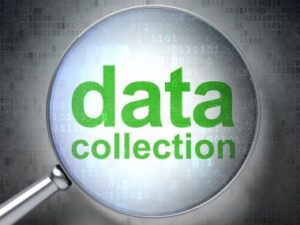what are the 5 best methods of collecting data?

Methods of collecting data
What are the 5 best methods of collecting data? The methods of collecting data are very important. Data collection is the process of collecting and analyzing information on relevant variables in a predetermined, methodical way so that one can respond to specific research questions, test hypotheses, and assess results.
Data collection as a main stage in research can overshadow the quality of achieving results by decreasing the possible errors which may occur during a research project. Therefore, alongside a good design for the study, plenty of quality time should be spent in the collection of data to gain appropriate results since insufficient and inaccurate data prevents assuring the accuracy of findings (Kabir, 2016). On the other hand, although a suitable data collection method helps to plan good research, it cannot necessarily guarantee the overall success of the research project (Olsen, 2012).

Data collection
Is the process of gathering and measuring information on variables of interest, in an established systematic fashion that enables one to answer stated research questions, test hypotheses, and evaluate outcomes. The data collection component of research is common to all fields of study including physical and social sciences, humanities, business, etc. While methods vary by discipline, the emphasis on ensuring accurate and honest collection remains the same.
The importance of ensuring accurate and appropriate data collection
Regardless of the field of study or preference for defining data (quantitative, qualitative), accurate data collection is essential to maintaining the integrity of research. Both the selection of appropriate data collection instruments (existing, modified, or newly developed) and clearly delineated instructions for their correct use reduce the likelihood of errors occurring.
Consequences from improperly collected data include
- inability to answer research questions accurately
- inability to repeat and validate the study
- distorted findings resulting in wasted resources
- misleading other researchers to pursue fruitless avenues of investigation
- compromising decisions for public policy
- causing harm to human participants and animal subjects
II. TYPES OF COLLECTING DATA
Before selecting a data collection method, the type of data that is required for the study should beccdetermined (Kabir, 2016). This section aims to provide a summary of possible data types to go throughcthe different data collection methods and sources of data based on these categories. However, we need tocunderstand what data is exactly? The embodied information in terms of figures or facts used to analyzecfor different calculations and finally gain a result to address the study question or hypothesis testing iscknown as data (Hurrel, 2005). Data can be categorized using different ways including quantitative and qualitative.
A. Qualitative Data
Both nominal and descriptive non-numerical data which cannot be shown as numbers are known asqualitative data in words or sentences format. This type of data answers to “how and why” questions in a research study and mostly covers data regarding feelings, perceptions, and emotions using unstructured approaches such as interviews for data collection. Researchers use different methods such as using audiotapes, sketches, notes, and photographs to gather these data.
Although qualitative data can be suitable to achieve further information to explore and determine new effects and consequences of programs on the research, and finally enhance the quality of quantitative results, its implementation is dependent on spending a considerable amount of cost and time and the results may not be generalizable. It means the findings of case studies can be used just for the same issues as the general patterns for different studies. Qualitative methods encompass three main categories including observations, document reviews, and in-depth interviews in spite of the fact that there are less common ways to gather qualitative data. In the next section, all of the methods of data collection are discussed.
B. Quantitative Data
Numerical data which is mathematically generated and computed is recognized as quantitative data. There are different scales for measuring quantitative data including nominal, ordinal, interval, and ratio scales (Kabir, 2016). Scales can be categorized into two general types as “Rating Scales and Attitude Scales” as well. Rating scales assign a numerical value to the points or categories to evaluate them. On the other hand, more complex methods are attitude scales that determine the predisposition of people toward any individual, phenomenon, or object (Taherdoost, 2016b).
A qualitative method addresses the “what” question type in a study. These approaches employ structured data collection methods and are based on random sampling. In comparison to the qualitative methods, these methods are regarded to be cheaper, and the findings can be standardized to achieve other results based on some criteria such as size. The findings can be easily generalized and summarized as well. A simple comparison between the results is also possible. Nevertheless, these methods also can face unexpected differences and some difficulties as the implementation and investigation capacity are limited in these methods. These approaches use different methods such as experiments and structured interviews for data collection which are discussed in the data collection methods section.
III. DATA COLLECTION METHODS
Generally, data collection methods are divided to two main categories of Primary Data Collection Methods and Secondary Data Collection Methods. Figure 1 shows some of data collection methods for primary and secondary data. Data that is not published yet and is the first-hand information which is not changed by any individual is known as primary data.
In other words, researchers use different approaches to gather and collect primary data for a specific purpose. Thus, the validity, reliability, objectivity, and authenticity of data are
more in primary data in comparison with the secondary data types. These qualities are important in some types of research methods such as statistical surveys as the use of the information is specific to a problem and cannot be provided from published references.
Thus, although the research can be conducted based on secondary data, it is not possible to achieve a reliable result without using primary data as well. As secondary data is manipulated and changed by others. Using primary sources, helps to gain high-quality data which can improve results, and you also have the opportunity to add further data when required during the research procedures. Primary data collection; however, can face difficulties in defining different terms in collecting data for example, the reasons behind data collection, what to collect, when to collect data, and the type of data collection method.

It is also an expensive approach, obtains the majority of research budget, and needs to provide funding resources from different agencies. You need to ensure the standard of collected data by accurately collecting them, eliminating unnecessary data and also not using fake and cooked-up ones. To achieve primary data, different sources can be used such as experiments, surveys, interviews, and questionnaires (Kabir, 2016; Taherdoost, 2021).
Secondary data is the data gathered from published sources meaning that the data is already gathered by someone else for another reason and can be used for other purposes in a research as well. In all papers, the literature review section is based on secondary data sources. Thus, secondary data is an essential part of research that can help to get information from past studies as basis conduction for implementing a research or as the required background information. It can also help to design a study and provide a baseline to compare primary results. However, it should be noted that researchers need to re-examine the validity and reliability of these backgrounds to gain authentic results.
There are different sources of secondary data such as records, books, research articles, and internet articles. Although they are not valid as much as primary data sources, these sources are still important for scientific studies as primary data collection is sometimes hard or impossible to obtain. Also, in some cases, the respondents do not allow to reveal data and the study should be conducted based on secondary data.
Generally, secondary data is cheaper and easier to obtain in comparison to primary data and there is no responsibility for the quality of data as it is just reported in the study. It also brings some disadvantages as it may not be reliable or accurate. It also cannot be used for a different situation for example environmental factors can affect the data and the time factor is important since sometimes it is required to use up-to-date data. Besides, copyright issues may happen (Hox & Boeije, 2005; Kabir, 2016)
3.1. PRIMARY DATA COLLECTION METHODS
Primary data collection is based on the processes by which you gather data yourself for your purpose of study and no one has access to use this data until it is published and both qualitative and quantitative approaches are used for this purpose. The main primary data collection is discussed here, considering 14 different types are listed in figure 1. The most common types are initially explained including questionnaires, interviews, focus groups, observation, survey, case studies, and experimental methods in detail. Then, other methods are reviewed shortly.
3.1.1. Questionnaire Method
The questionnaire is one of the common devices for collecting information and a form or instrument including a set of questions and secure answers that respondents (from a specific population) fill to give the researcher information needed for the study. The data given from a questionnaire cannot be achieved from the secondary resources (Pandey & Pandey, 2015). These forms are suitable to gather both qualitative and quantitative data. Although they are not the most common methods used in qualitative research, they are useful in case of facing a large sample in a study.
Sir Francis Galton designed a questionnaire for the first time. A questionnaire is utilized for different purposes, although it is commonly used to gather statistical data. It can be designed for measuring separate variables such as behaviors, preferences, and facts (Kabir, 2016). Although the preparation and administration of a questionnaire are not hard, specific points in these processes should be required. This form is used, normally, when it is not possible to discuss each participant personally (Pandey & Pandey, 2015). Thus, it helps to gather data from different individuals, groups, and companies easily.
Questionnaires can be categorized based on different aspects such as types of questions and administration modes. A) Types of Questions First, questions can be designed to measure variables for example in a survey. On the other hand, questions can be based on aggregating into indexes or scales, for instance in tests. Second, question types can be categorized into closed-ended and open-ended questions.
In close-ended questions, the respondents face a specific range of answers to choose from, but the respondent is asked to provide formulated answers using open-ended questions. Qualitative questions are open-ended (Taherdoost, 2019). In this type, then, the answers should be coded into a response scale. Therefore, in comparison to the open-ended questions, close-ended ones are pre-coded to make the work quickly be implemented (Olsen, 2012).
For close-ended questions, there are four types of options to respond the questions:
● You can have a two-option as the responses possibilities which are known as dichotomous scales.
● If you add more than two options for the respondents, the scale is known as nominalpolychromous.
● In ordinal-polytomous scales, you prepare more than two options which are also ordinal.
● Finally, you can use continuous or bounded types which use a continuous scale as a possible
response case.